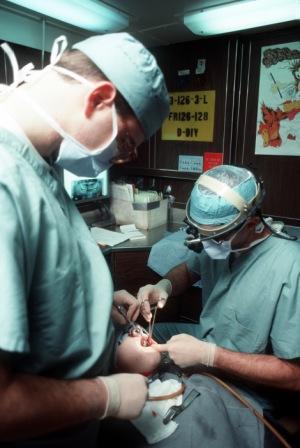Dental surgery

Dental surgery is any of a number of medical procedures which involve artificially modifying the dentition.
Types
Some of the more common are:
- Endodontic (surgery involving the pulp or root of the tooth)
- Root canal
- Pulpotomy The opening of the pulp chamber of the tooth to allow an infection to drain; Usually a precursor to a root canal
- Pulpectomy - The removal of the pulp from the pulp chamber to temporarily relieve pain; Usually a precursor to a root canal.
- Apicoectomy - A root-end resection. Occasionally a root canal alone will not be enough to relieve pain and the end of the tooth, called the apex, will be removed by entering through the gingiva and surgically extracting the diseased material.
- Root canal
- Prosthodontic (dental prosthetics)
- Crowns (caps) — artificial coverings of the tooth made from a variety of materials, including CMC/PMC (ceramic/porcelain metal composite), gold or a tin/aluminum mixture. The underlying tooth must be reshaped to accommodate these
- Veneers — artificial coverings similar to above, except that they only cover the forward (labial or buccal) surface of the tooth. Usually for aesthetic purposes only.
- Bridges — a set of two or more fused crowns which bridge a missing tooth (teeth). Typically used after an extraction.
- Implants — a procedure in which a base is set into the bone (mandible or maxilla), allowed to heal, and months later an artificial tooth is screwed into place.
- Dentures (false teeth) — a partial or complete set of dentition which either attach to neighboring teeth by use of metal or plastic grasps or to the gingival or palatial surface by use of adhesive.
- Implant-supported prosthesis — a combination of dentures and implants, bases are placed into the bone, allowed to heal, and metal appliances are fixed to the gingival surface, following which dentures are placed atop and fixed into place.
- Orthodontic treatment
- Implants and implant-supported prosthesis — also an orthodontic treatment as it involves bones
- Apiectomy — also an orthodontic treatment as part of the underlying bone structure must be removed.
- Extraction — a procedure in which a diseased, redundant, or problematic tooth is removed, either by pulling or cutting out. This procedure can be done under local or general anesthesia and is very common — many people have their wisdom teeth removed before they become problematic.
- Fiberotomy — a procedure to sever the fibers around a tooth, preventing it from relapsing.
Professional dental care
Regular tooth cleaning by a dental professional is recommended to remove tartar (mineralized plaque) that may develop even with careful brushing and flossing, especially in areas of the mouth that are difficult to clean. Professional cleaning includes tooth scaling and tooth polishing, as well as debridement if too much tartar has accumulated. This involves the use of various instruments and/or devices to loosen and remove tartar from the teeth. Most dental hygienists recommend having the teeth professionally cleaned at least every six months[citation needed].
More frequent cleaning and examination may be necessary during the treatment of many different dental/oral disorders or due to recent surgical procedures such as dental implants. Routine examination of the teeth by a dental professional is recommended at least every year. This may include yearly, select dental X-rays. See also dental plaque identification procedure and removal.
Dental instruments and restorative materials
Dental anesthesia
Dentists inject anesthetic to block sensory transmission by the alveolar nerves. The superior alveolar nerves are not usually anesthetized directly because they are difficult to approach with a needle. For this reason, the maxillary teeth are usually anesthetized locally by inserting the needle beneath the oral mucosa surrounding the teeth. The inferior alveolar nerve probably is anesthetized more often than any other nerve in the body. To anesthetize this nerve, the dentist inserts the needle somewhat posterior to the patient’s last molar.
See also
References
This article needs additional citations for verification. (November 2007) (Learn how and when to remove this template message) |